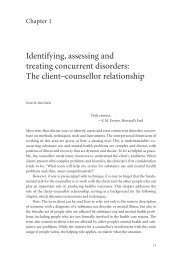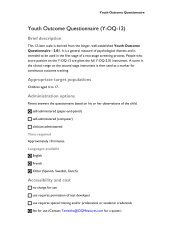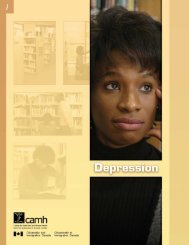Cognitive-behavioural therapy: An information guide - CAMH ...
Cognitive-behavioural therapy: An information guide - CAMH ...
Cognitive-behavioural therapy: An information guide - CAMH ...
Create successful ePaper yourself
Turn your PDF publications into a flip-book with our unique Google optimized e-Paper software.
CBT approaches to <strong>behavioural</strong> change<br />
29<br />
Scheduling activities<br />
The same schedule used in Table 3 to monitor activities and make<br />
pleasure and mastery ratings may also be used to help you schedule.<br />
One use is to schedule activities that you may have been avoiding.<br />
This can help to remove indecisiveness around whether or not<br />
you should do an activity. For instance, if you decide in advance<br />
that you will go to the gym between 5:00 p.m. and 6:00 pm on<br />
Tuesday, you are more likely to go than if you wait to decide based<br />
on how you feel that day.<br />
The therapist may also ask you to schedule both pleasurable activities<br />
(e.g., lunch with a friend) and mastery tasks (e.g., organizing and<br />
paying bills) for the upcoming week. You will likely also be asked to<br />
keep track of your automatic thoughts during your weekly activities<br />
to help you identify distortions or other appraisals that minimize<br />
or undermine your pleasure or sense of mastery in the activity.<br />
A further use of the activity schedule is to help you recognize the<br />
barriers to completing tasks and to break down these tasks into<br />
smaller units to make the tasks less distressing and more likely<br />
to be accomplished. “Graded tasks” can then be constructed where<br />
you schedule the easier steps of the task before getting to more<br />
complicated and challenging parts of the task. Simply changing the<br />
structure and the approach to tasks in this way can create remarkable<br />
changes in the likelihood that you will accomplish tasks.<br />
Exposure <strong>therapy</strong><br />
A standard component of cbt treatment for anxiety is exposure<br />
<strong>therapy</strong>. Exposure <strong>therapy</strong> works to reduce your fear of certain<br />
things (e.g., insects, snakes) or situations (e.g., closed spaces,<br />
heights) by gradually increasing your exposure to the feared thing

















